Submissions: 2022 February
-
blastrophoto
- Ensign
- Posts: 11
- Joined: Sun Nov 14, 2021 9:54 pm
Re: Submissions: 2022 February
THE SWORD OF ORION
IC 420, M42, M43, NGC 1973, NGC 1975, NGC 1976, NGC 1977, NGC 1980, NGC 1981, and NGC 1982
https://live.staticflickr.com/65535/518 ... 7c45_k.jpg
The Great Nebula in Orion, an immense, nearby star birth region, is probably the most famous of all astronomical nebulas. Here, glowing gas surrounds hot young stars at the edge of an immense interstellar molecular cloud only 1500 light-years away. In this image, excited hydrogen atoms take up the dominant source of color, light and detail, making a vibrant sea of red gas. Wisps and sheets of dust and oxygen-3 are also particularly evident. The Great Nebula in Orion can be found with the unaided eye near the easily identifiable belt of three stars in the popular constellation Orion. In addition to housing a bright open cluster of stars known as the Trapezium, the Orion Nebula contains many stellar nurseries. These nurseries contain much hydrogen gas, hot young stars, proplyds, and stellar jets spewing material at high speeds. Also known as M42, the Orion Nebula spans about 40 light years and is located in the same spiral arm of our Galaxy as the Sun.
This image comes in at 13 hours of exposure time, captured from my Bortle 6 backyard. I spent two nights testing a new telescope configuration and tested using a new piece of software to capture my data. With M42 being so bright I thought it was the perfect target to test with. The image is composed of multiple layered stretches to achieve an HDR composite. I processed trapezium separately and then later added it to blend with the almost finalized image. This allowed me to really boost details and brightness in otherwise faint regions without sacrificing the details in trapezium.
First Telescope Rig: 6.75hrs (135 x 60sec - per filter)
Explore Scientific ED80 FCD100 (312mm f3.9)
ASI294MM 2x2bin
APEX-S .65x reducer
Optolong 2” RGB filters
Second Telescope Rig: 6.5hrs (57 x 180sec)
Orion ED80 Doublet (390mm F4.8)
ASI2600mm
APEX-L .65x Reducer
Astronomik 2” Ha 12nm filter
Location:
Woodbridge, VA (Bortle 6)
IC 420, M42, M43, NGC 1973, NGC 1975, NGC 1976, NGC 1977, NGC 1980, NGC 1981, and NGC 1982
https://live.staticflickr.com/65535/518 ... 7c45_k.jpg
The Great Nebula in Orion, an immense, nearby star birth region, is probably the most famous of all astronomical nebulas. Here, glowing gas surrounds hot young stars at the edge of an immense interstellar molecular cloud only 1500 light-years away. In this image, excited hydrogen atoms take up the dominant source of color, light and detail, making a vibrant sea of red gas. Wisps and sheets of dust and oxygen-3 are also particularly evident. The Great Nebula in Orion can be found with the unaided eye near the easily identifiable belt of three stars in the popular constellation Orion. In addition to housing a bright open cluster of stars known as the Trapezium, the Orion Nebula contains many stellar nurseries. These nurseries contain much hydrogen gas, hot young stars, proplyds, and stellar jets spewing material at high speeds. Also known as M42, the Orion Nebula spans about 40 light years and is located in the same spiral arm of our Galaxy as the Sun.
This image comes in at 13 hours of exposure time, captured from my Bortle 6 backyard. I spent two nights testing a new telescope configuration and tested using a new piece of software to capture my data. With M42 being so bright I thought it was the perfect target to test with. The image is composed of multiple layered stretches to achieve an HDR composite. I processed trapezium separately and then later added it to blend with the almost finalized image. This allowed me to really boost details and brightness in otherwise faint regions without sacrificing the details in trapezium.
First Telescope Rig: 6.75hrs (135 x 60sec - per filter)
Explore Scientific ED80 FCD100 (312mm f3.9)
ASI294MM 2x2bin
APEX-S .65x reducer
Optolong 2” RGB filters
Second Telescope Rig: 6.5hrs (57 x 180sec)
Orion ED80 Doublet (390mm F4.8)
ASI2600mm
APEX-L .65x Reducer
Astronomik 2” Ha 12nm filter
Location:
Woodbridge, VA (Bortle 6)
Last edited by bystander on Mon Feb 28, 2022 4:26 pm, edited 1 time in total.
Reason: Please, no hot links to images > 500 kb.
Reason: Please, no hot links to images > 500 kb.
-
Mysterium Cosmographicum
- Asternaut
- Posts: 4
- Joined: Fri Feb 25, 2022 4:55 pm
Re: Submissions: 2022 February
Hi there. I'm a newbie I hope pleased with my contributions. Tis is a modest picture of Orion Nebula toked in my house garden. I don' t have great dark sky, but the gidance this day was in the right track. I don´t know if I did anything wrong about size image in Mb, attaching the following image. If the answer is yes please tell me the right way to do it. I've read the posting rules but I think I didn't fully understad them. Thanks.
--------------------
http://www.ourenseastronomico.org/wp-co ... inal-2.jpg
Best whises
--------------------
http://www.ourenseastronomico.org/wp-co ... inal-2.jpg
Best whises
Last edited by bystander on Sat Feb 26, 2022 4:43 am, edited 1 time in total.
Reason: Please, no hot links to images > 500 kb.
Reason: Please, no hot links to images > 500 kb.
Re: Submissions: 2022 February
Hi Alejandro and welcome to Starship Asterisk*!Mysterium Cosmographicum wrote: ↑Fri Feb 25, 2022 5:50 pm Hi there. I'm a newbie I hope pleased with my contributions. Tis is a modest picture of Orion Nebula toked in my house garden. I don' t have great dark sky, but the gidance this day was in the right track. I don´t know if I did anything wrong about size image in Mb, attaching the following image. If the answer is yes please tell me the right way to do it. I've read the posting rules but I think I didn't fully understad them. Thanks.
--------------------
http://www.ourenseastronomico.org/wp-co ... inal-2.jpg
Best whises
As you can see, your image does not show up in your post. I wish I knew how you should post it, but I don't. However, I posted your image as an attachment, so that people can see it.
Color Commentator
-
Mysterium Cosmographicum
- Asternaut
- Posts: 4
- Joined: Fri Feb 25, 2022 4:55 pm
Re: Submissions: 2022 February
Oh! That is a wonderful job, thanksHi Alejandro and welcome to Starship Asterisk*!
As you can see, your image does not show up in your post. I wish I knew how you should post it, but I don't. However, I posted your image as an attachment, so that people can see it.
-
andrystix
Re: Submissions: 2022 February
 CRISTO DELLE MARCHE by Andrea Amici - AndryStix
CRISTO DELLE MARCHE by Andrea Amici - AndryStixHere is my first and only attempt of Orion Complex taken the 23th of February in Cingoli, Marche (Italy).
After checking up the field (the Sky was around Bortle scale 4), I decided to use my 70-200 @70mm to made this panorama of 3 panels.
For the Orion Complex, I've taken 36 shots to make 18min of data approx, tracked with my iOptron Sky Guider Pro first and stacked with DSS.
For the "middle" sky and the foreground I've just taken 1 only shot.
Same setting for each picture: 30sec, ISO 1270, F/4 @70mm.
Nikon D750 (modded), Nikon AF-S 70-200mm f/2.8 G ED VR II, iOptron Sky Guider Pro
@andrystix on IG, FB and Flickr
-
Jean-Baptiste Auroux
- Ensign
- Posts: 76
- Joined: Tue Nov 14, 2017 10:06 pm
Re: Submissions: 2022 February
Liberty for Ukraine !
Full version : https://millenniumphoton.com/wp-content ... raine2.jpg
We who observe the sky know well that we are all part of the same world, so fragile and insignificant on the scale of the universe. We should all collaborate together in good intelligence rather than devote our limited energy and resources to killing each other.
The point here is not to "hijack" astronomy for political purposes, but to share a message of hope and humanity.
Copyright: Jean-Baptiste Auroux - https://millenniumphoton.com/
Full version : https://millenniumphoton.com/wp-content ... raine2.jpg
We who observe the sky know well that we are all part of the same world, so fragile and insignificant on the scale of the universe. We should all collaborate together in good intelligence rather than devote our limited energy and resources to killing each other.
The point here is not to "hijack" astronomy for political purposes, but to share a message of hope and humanity.
Copyright: Jean-Baptiste Auroux - https://millenniumphoton.com/
-
barretosmed
- Science Officer
- Posts: 463
- Joined: Thu Oct 12, 2017 6:04 pm
Re: Submissions: 2022 February
NEPTUNE, TRITON AND THE DEEP SKY
Some people always ask how Neptune would be related to the star field around it, so I decided to make a slightly different picture. using the capture processing technique we use for deep sky photography.
In the image we can see Neptune and Triton, in the center, in a field of stars using a 1050mm focal length telescope applying 2x digital drizze. The star above is HD221801
BEST DETAILS:
https://www.astrobin.com/full/brlrvw/0/
EQUIPMENTS:
ZWO ASI 6200MC COLED
Esprit 150mm
Mount CEM60
41x 50'' exposure
08/08/2021
Location: Jales - SP - Brazil
Author: Fernando Oliveira de Menezes
(Organizing author of the book Amateur Astrophotography in Brazil)
https://clubedeautores.com.br/livro/ast ... -no-brasil
Some people always ask how Neptune would be related to the star field around it, so I decided to make a slightly different picture. using the capture processing technique we use for deep sky photography.
In the image we can see Neptune and Triton, in the center, in a field of stars using a 1050mm focal length telescope applying 2x digital drizze. The star above is HD221801
BEST DETAILS:
https://www.astrobin.com/full/brlrvw/0/
EQUIPMENTS:
ZWO ASI 6200MC COLED
Esprit 150mm
Mount CEM60
41x 50'' exposure
08/08/2021
Location: Jales - SP - Brazil
Author: Fernando Oliveira de Menezes
(Organizing author of the book Amateur Astrophotography in Brazil)
https://clubedeautores.com.br/livro/ast ... -no-brasil
- the_astronomy_enthusiast
- Ensign
- Posts: 98
- Joined: Fri Apr 16, 2021 10:16 pm
- Contact:
Re: Submissions: 2022 February

The dim and detailed jellyfish: A 112-hour collaboration from three continents! by William Ostling, on Flickr
The full quality images can be viewed here:
Regular: https://live.staticflickr.com/65535/519 ... 5c01_o.png
Starless: https://live.staticflickr.com/65535/519 ... e064_o.png
The jellyfish nebula is a notoriously dim object in the night sky. As a result, most images of this nebula are highly denoised, leading to a loss of detail. But by combining nearly 1000 exposures and 6740 minutes of exposure from collaborators across three continents for a total integration time of 112.4 hours, we were able to reveal structures and detail previously not displayed by previous images.
In this image, channels are mapped in the classic Hubble palette, where ionized sulfur is represented by red, ionized hydrogen is represented by green, and ionized oxygen is represented by blue.
The Jellyfish Nebula is a stupendously complicated nebula created by the remains of a massive star that exploded. In the center of this jellyfish lies interweaving tendrils of hydrogen, sulfur, and wispy oxygen warped by an intragalactic wind coming from the northeast. Dark lanes of inert dust obscure small portions of the Jellyfish. The bowshock-like “head” of the jellyfish was most likely formed by its contact with the denser nebulosity to the left of the jellyfish. The Sulfur and Oxygen tendrils escaping the Jellyfish to the left and to the bottom are most likely a result of unstable magnetic fields from the supernova. The field of nebulosity to the right, although unrelated to the supernova, greatly affects the movement of the supernova’s western region.
Acquisition: Andy Brown (@abastrophotouk), Dominic (@domnuch), Jay Aigner (@aignerastro), Oliver Carter (@bright_ascension), Tommy Lease (@colorado_astro), Jens Unger (@jazz.astro), Sendhil (@deepskyimaging), Justin P. (@justadudewitha_camera_)
Image processing: William Ostling (@the_astronomy_enthusiast), Justin P. (@justadudewitha_camera_)
Data details:
Ha: 2750 minutes, 389 subframes
Sii: 1930 minutes, 271 subframes
Oiii: 2060 minutes, 277 subframes
Pre-processing and stacking
- All subframes were weighted in subframe selector based on the following formula:
+ 18*(1-(FWHM-FWHMMin)/(FWHMMax-FWHMMin))
+ 14 *(SNRWeight-SNRWeightMin)/(SNRWeightMax-SNRWeightMin)
+ 20
- Each subframe was star aligned with distortion correction. Some subframes were cropped to aid the star alignment
Subframes were integrated using the linear fit clipping rejection algorithm
Subframes were drizzled with a scale of 1 to remove star alignment artifacts from the final master images
- each channel was star aligned to H-alpha with distortion correction on
Several iterations of DBE were applied to remove gradients
Creating a luminance
- Each master was stretched using the default STF settings
The following pixelmath formula was applied: (Ha + max(Ha, Sii) + max(Ha, Oiii))/3
A re-linearization was applied with a mid tones level of .999367
- A PSF was created using the dynamic PSF process
A starmask was created using Starnet 2, morphological transformation, and convolution
Deconvolution was applied with local deringing
- A low-contrast mask was applied
Two iterations of TGV noise reduction were applied, one targeting high-frequency noise and one targeting low-frequency noise
A medium-contrast mask was applied
MMT targeting all 8 scales was applied to remove large-scale noise
- due to the High-contrast nature of the nebula, the masters were stretched using Masked Stretch
a histogram transformation with a 0% black clip was applied
Masked stretch with 1000 iterations, a black level of .1 was applied to each master
- The SHO channels were combined using channel combination
The resulting image was inverted and SCNR was applied
Starnet 2 was applied to the image
LRGB combination using the master luminance was applied
- Star reduction using Adam Block's method
Histogram channels were matched using histogram transformation
Overall brightness adjustments using curves
Color adjustments using curves and color masks
Using a green color mask, green levels were brought down and red levels were brought up
Using a red color mask, the hue was shifted slightly towards red
Using a blue color mask, blue and green levels were increased and red levels were decreased
Saturation adjustments
The luminance and SV components were extracted
The pixelmath formula L * ~SV was applied to create a saturation mask
saturation values were increased using the mask
Iterative color and saturation adjustments were applied
Non-linear noise reduction
A mask was created to target background areas
MLT was applied targeting 5 layers of luminance
MMT was applied targeting 4 layers of chrominance
More brightness adjustments were applied using curves transformation
Re: Submissions: 2022 February
New pseudo color images (made from less than 3 colors) of SH2-86, M27 and SH2-105
Click on the images for detailed information, more views and full resolution pictures.
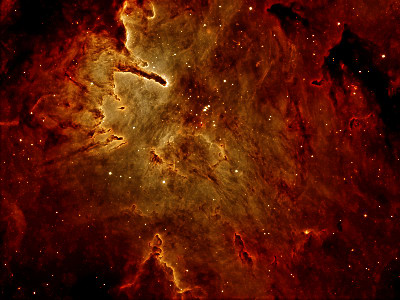
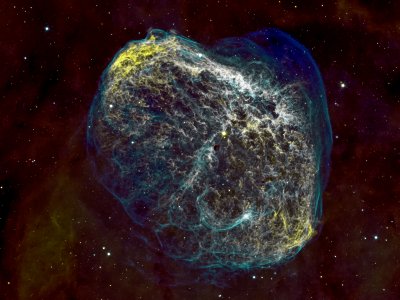
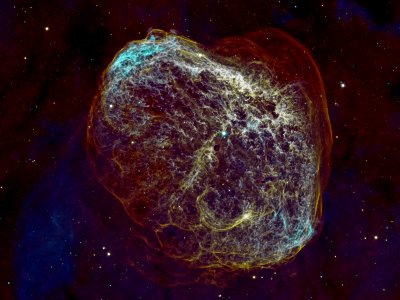
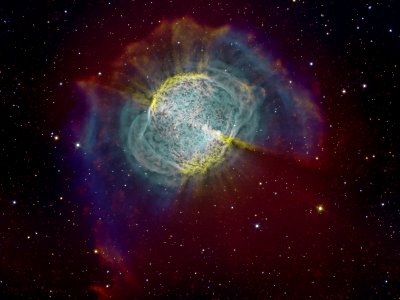
---
My Homepage
RSS news feed
Click on the images for detailed information, more views and full resolution pictures.




---
My Homepage
RSS news feed
-
blastrophoto
- Ensign
- Posts: 11
- Joined: Sun Nov 14, 2021 9:54 pm
Re: Submissions: 2022 February
SH2-240 - The Spaghetti Nebula
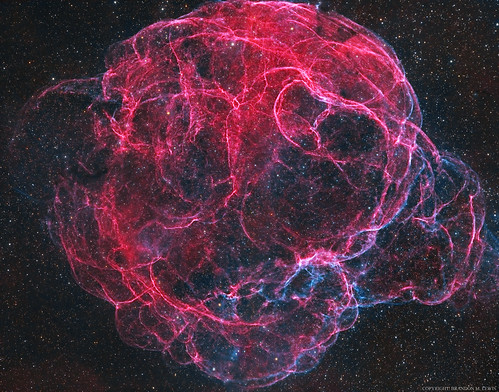
https://live.staticflickr.com/65535/519 ... f2ba_k.jpg
Simeis 147, also known as the Spaghetti Nebula, SNR G180.0-01.7 or Sharpless 2-240, is a supernova remnant (SNR) in the Milky Way, straddling the border between the constellations Auriga and Taurus. Discovered in 1952 at the Crimean Astrophysical Observatory using a 25-inch Schmidt-Cassegrain telescope, it is difficult to observe due to its extremely low brightness. It is believed that after its stellar explosion a rapidly spinning neutron star known as pulsar PSR J0538+2817 was left behind in the nebula core, emitting a strong radio signal.
Seventy five hours total exposure time, captured from my suburban backyard under Bortle 6 skies. The project folder occupied roughly 800GB of storage from a combination of original, calibrated, registered, normalized scale gradient, debayered, and processed files.
This is a 2 panel mosaic, captured at 390mm and 312mm, paired with an ASI2600mm and ASI294MM. I started working on this at the beginning of January with two 80mm refractor APO telescopes. One telescope focused on OIII and the other focused on HA. After I collected about 30 hours for each panel with these filters, I spent another 15 hours collecting RGB data. I used a combination of 60 second, 300 second, and 600 second sub-exposures. I had to crop the framing a bit for each set of data to match and stitch together however I still kept the entire bubble in frame which I was quite pleased about. Post was not too terrible. I considered stretching the data further to make the structure pop more but I also didn’t want to be aggressive with noise reduction and I really like the fine details here so I kept it tame and I like the result.
Gear:
Mount - Orion Sirius EQ-G
(First Telescope)
Explore Scientific ED80 Triplet FCD100 - 312mm f3.9
ASI294MM - 2x2bin (Astronomik 2" 12nm OIII)
APEX-S .65x reducer
294MC Pro - 1x1 bin (RGB Data)
(Second Telescope)
Orion ED80 Doublet - 390mm F4.8
ASI2600mm
Astronomik 2” Ha 12nm filter
APEX-L .65x Reducer
Exposure Times:
RGB - 699 x 60 seconds = 11hr 39min
Ha - 76 x 600 seconds = 12hr 40min
Ha - 270 x 300 seconds = 22hr 30min
OIII - 170 x 600 seconds = 28hr 20min
Total: 75hr 9min
Captured: January 10th 2022 - February 8th 2022
Location: Woodbridge, VA

https://live.staticflickr.com/65535/519 ... f2ba_k.jpg
Simeis 147, also known as the Spaghetti Nebula, SNR G180.0-01.7 or Sharpless 2-240, is a supernova remnant (SNR) in the Milky Way, straddling the border between the constellations Auriga and Taurus. Discovered in 1952 at the Crimean Astrophysical Observatory using a 25-inch Schmidt-Cassegrain telescope, it is difficult to observe due to its extremely low brightness. It is believed that after its stellar explosion a rapidly spinning neutron star known as pulsar PSR J0538+2817 was left behind in the nebula core, emitting a strong radio signal.
Seventy five hours total exposure time, captured from my suburban backyard under Bortle 6 skies. The project folder occupied roughly 800GB of storage from a combination of original, calibrated, registered, normalized scale gradient, debayered, and processed files.
This is a 2 panel mosaic, captured at 390mm and 312mm, paired with an ASI2600mm and ASI294MM. I started working on this at the beginning of January with two 80mm refractor APO telescopes. One telescope focused on OIII and the other focused on HA. After I collected about 30 hours for each panel with these filters, I spent another 15 hours collecting RGB data. I used a combination of 60 second, 300 second, and 600 second sub-exposures. I had to crop the framing a bit for each set of data to match and stitch together however I still kept the entire bubble in frame which I was quite pleased about. Post was not too terrible. I considered stretching the data further to make the structure pop more but I also didn’t want to be aggressive with noise reduction and I really like the fine details here so I kept it tame and I like the result.
Gear:
Mount - Orion Sirius EQ-G
(First Telescope)
Explore Scientific ED80 Triplet FCD100 - 312mm f3.9
ASI294MM - 2x2bin (Astronomik 2" 12nm OIII)
APEX-S .65x reducer
294MC Pro - 1x1 bin (RGB Data)
(Second Telescope)
Orion ED80 Doublet - 390mm F4.8
ASI2600mm
Astronomik 2” Ha 12nm filter
APEX-L .65x Reducer
Exposure Times:
RGB - 699 x 60 seconds = 11hr 39min
Ha - 76 x 600 seconds = 12hr 40min
Ha - 270 x 300 seconds = 22hr 30min
OIII - 170 x 600 seconds = 28hr 20min
Total: 75hr 9min
Captured: January 10th 2022 - February 8th 2022
Location: Woodbridge, VA
Last edited by bystander on Mon Feb 28, 2022 4:25 pm, edited 1 time in total.
Reason: Please, no hot links to images > 500 kb.
Reason: Please, no hot links to images > 500 kb.
-
varadinagypal
- Ensign
- Posts: 81
- Joined: Fri Dec 20, 2013 9:29 pm
Re: Submissions: 2022 February
The Sun in Calcium K shows prominences
https://csillagtura.ro/solar-prominence ... 022-02-25/
Copyright: Pál VÁRADI NAGY Full rez https://csillagtura.ro/wp-content/uploa ... rcumZC.jpg
It took a lot of editing to dig out the prominences of the unfavorable dynamic range and the inherent reflection of the instrument, but I think I did a decent job. ASI 178MM (cooled), Lunt CaK B600 LS6CAKMDS2, Skywatcher 72/420 ED-APO, mountpusher, EQ3-mod
https://csillagtura.ro/solar-prominence ... 022-02-25/
Copyright: Pál VÁRADI NAGY Full rez https://csillagtura.ro/wp-content/uploa ... rcumZC.jpg
It took a lot of editing to dig out the prominences of the unfavorable dynamic range and the inherent reflection of the instrument, but I think I did a decent job. ASI 178MM (cooled), Lunt CaK B600 LS6CAKMDS2, Skywatcher 72/420 ED-APO, mountpusher, EQ3-mod
-
tommasostella
- Ensign
- Posts: 58
- Joined: Mon Nov 11, 2019 4:34 pm
Re: Submissions: 2022 February
The Angel Nebula NGC 2170
https://www.facebook.com/tommaso.m.stella
Copyright: Tommaso Stella
From: Taranto (Italy)
Technical data
Sky: Bortle 5/6
Lights: 71x300s (2021) + 59x600s (2022) (15,7h total integration)
Telescope: TS PhotoLine Apochromatic FPL53 Triplet 102/714
Camera: QHY 168C
Mount: Skywatcher AZ-EQ6 GT
Filters: Optolong Astronomy Filter L-CCD
Processing: DeepSkyStacker, Photoshop CC, PixInsight
https://www.facebook.com/tommaso.m.stella
Copyright: Tommaso Stella
From: Taranto (Italy)
Technical data
Sky: Bortle 5/6
Lights: 71x300s (2021) + 59x600s (2022) (15,7h total integration)
Telescope: TS PhotoLine Apochromatic FPL53 Triplet 102/714
Camera: QHY 168C
Mount: Skywatcher AZ-EQ6 GT
Filters: Optolong Astronomy Filter L-CCD
Processing: DeepSkyStacker, Photoshop CC, PixInsight

